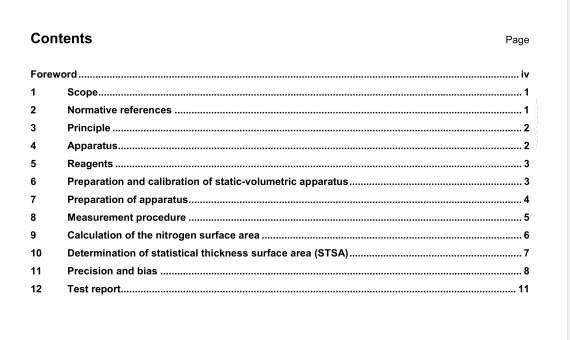ISO 18852 pdf download – Rubber compounding ingredients – Determination of multipoint nitrogen surface area (NSA) and statistical thickness surface area (STSA).
4.4 Pressure gauge or transducer, with a reading accuracy of ± 0,25% or ± 70 Pa (± 0,5 mmHg),
covering the range 0 kPa to 135 kPa (0 mmHg to 1 000 mmHg).
4.5 Small glass vials with caps (about 30 cm3), for oven-drying samples.
4.6 Analytical balance, with 0,1 mg sensitivity
4.7 Heating mantle o degassing station, capable of maintaining a temperature of 300 C ± 10 C.
4.8 Calibration volume, consisting of a cyiindrical or spherical glass (or corrosion-resistant metal) reservoir. having an internal volume between 75 cm3 and 500 au3, and with a valve or stopcock and a connector by which It can be connected to the sample port of the gas adsorption apparatus.
5 Reagents
5.1 Reagent-grade chemicals, conforming to the specified or recommended standards for laboratory
cherrucals, shall be used m all tests,
5.2 Water. distilled, or of equivalent purity.
5.3 LIquid nitrogen 98 % or higher purity
5.4 Ultra-high-purIty nitrogen gas, from a cylinder or other suitable source,
5.5 Ultra-high-purIty helium gas from a cylinder or other suitable source,
5.6 HIgh-vacuum stopcock grease
6 Preparation and calibration of static-volumetric apparatus
6.1 This procedure shall be performed for the initial calibration, periodically as a quality control measure. and following repairs or adjustments. If a commercial apparatus is used, consult the users manual for specific instructions in carrying out the steps wtiicl, follow.
6.2 Attach the vacuum arid pressure gauges or transducers (4.3 and 4.4) to the apparatus and evacuate it. the manifold and all internal pressureA,acuum sensors to 2.7 Pa (20 pmHg) or below.
6.3 Verify that the internal vacuum sensor(s) are reading correctly and that the internal pressure sensor(s) are reading correctly In the vicinity of zero pressure, taking into account the expected resolution and stability limits. Make adjustments as needed.
6.4 Close the vacuum path and admit nitrogen gas to build 100 kPa * I % (750 mmHg * 7,5 mmHg) of pressure. Verify that ttie pressure sensors read the correct pressure to within ± 0.25 %. Make adjustments as needed
6.5 Thoroughly clean and dry an empty adsorption cell (4.2). Connect ii to the apparatus and evacuate it to
2,7 Pa (20 imI1g). Apply a 300 C heating mantle and continue evacuation for at least 1 Ii and until the rate of
pressure rise upon temporarily closing the vacuum path is under 0.4 Pa (3 mHg) per minute.
6.6 Perform a blank analysis” on this clean empty oel at 0.05; 0.10; 0,15; 0,20 and O,25pIp. Use a value” of 101.325 kPa (760 mmHg) and a “test portion mass” of 1 g for the calculations.
6.7 ExamIne the mean value of the “adsorbed quantities’ obtained. Ideally, this should be zero. A single reading exceeding 0.25 standard cm3 makes the set-up unacceptable. As a rule, only readings below 0,125 standard cm3 are acceptable although one of them may go as high as 0,25 standard cm3. A parabolic error versus pressure profile may indicate failure to correct properly for non-ideal gas behaviour or transducer linearity problems. A linear error profile indicates failure to property measure or account for unadsorbed gas (free-space error). Erratic variation of data points indicates leaks or noisy measurements.
6.8 Determine the internal volume 01 the calibration-volume reservoir (4.8) below the valve or stopcock by the difference In mass when empty and then when filled completely with distiled water (5.2). Measure the water temperature and use the correct water density to obtain the exact volume of water contained, It may be necessary to immerse the device in boiling water to ensta’e complete filling and degassing. Repeat the procedure until the caltration volume is known to better than 0,1 %. Empty the calibration volume and thoroughly dry It overnight In the vacuum oven at 70 ÔC ± Sac.
6.9 Connect the calibration-volume reservoir to a sample port of the gas adsorption apparatus, open the valve or stopcock, and evacuate the reservoir to below 2,7 Pa (20 pmHg). Continue evacuation for one more hour. Close off the path to the vacuum source and note whether any rise in pressure occurs. The pressure shall remain below 2.7 Pa (20 pmHg), with a rate of increase of less than 0.04 Pa (0.3 pmHg) per minute. When this has been achieved, dose the valve or stopcock to maintain the vacuum within the calibration- volume reservoir,
6.10 Leave the closed-off, evacuated calibration-volume reservoir in place. Raise a Oewar flask (or other insulating container) around it and pack wet, crushed ice firmly ii the Dewar flask. Ptace an insulating cover on the Ica Start an analysis with target relative pressures of 0,025: 0,05: 0,10; 0,15; 0,20 and 0.25p/p0.
ISO 18852 pdf download – Rubber compounding ingredients – Determination of multipoint nitrogen surface area (NSA) and statistical thickness surface area (STSA)
